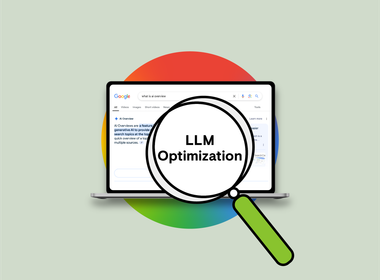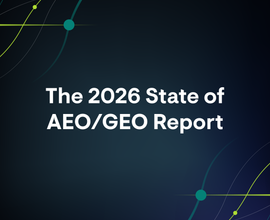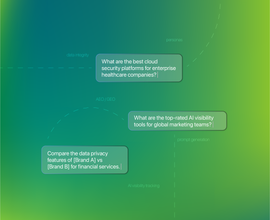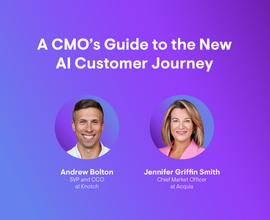What is LLM Optimization? LLM Optimization Explained
Large language models (LLMs) like ChatGPT and Gemini are transforming how businesses operate and how we all find information, and the industry is responding by finding new ways to optimize for this AI-focused world. The result has been a lot of acronyms that can get pretty confusing to try to pull apart.
Curious what LLM optimization is, how it differs from concepts like AI optimization, and answer engine optimization? You’re not alone. Explore LLM optimization, understand why it’s so important, and how it differs from other critical AI optimization processes.
What is a large language model (LLM)?
A large language model, or LLM, is a kind of artificial intelligence that’s designed to understand, generate, and interact with language. Think of it as an AI "brain" trained on a massive amount of text and data from the internet, books, and other sources. This extensive training allows it to recognize patterns, context, and nuances in language, so it can answer questions, write essays, translate languages, summarize documents, and engage in full-on conversations. Popular examples of systems that use LLMs include ChatGPT, Google's Gemini, and Claude .
What is LLM optimization?
Similar to AI optimization, there are a couple of different ways of looking at LLM optimization. Specifically, LLM optimization can mean one of two things: most often, it refers to the technical processes of improving the performance, efficiency, and accuracy of a large language model.
It also sometimes refers to the process of improving a brand’s presence, visibility, and authority on LLMs. This second way is similar to answer engine optimization (AEO) and generative engine optimization (GEO)Generative Engine Optimization (GEO)
GEO is the process of optimizing content to increase visibility and citations within AI-powered search experiences like AI Overviews and LLMs.
Learn more.
Useful resources:
Check out a few of our resources to learn more about optimizing your content for improved performance on LLMs.
I think context matters. There are very few companies on the planet that are actually trying to optimize LLMs, so if you're in marketing or you’re talking about brands, [LLM optimization likely means] how do you appear? Or how do you get found?
There are several key techniques for optimizing LLMs for greater efficiency and performance. Fine-tuning, for example, involves taking a pre-trained model and training it on a smaller, specialized dataset to make it an expert in a particular subject, like legal contracts or medical terminology. Another technique is prompt engineering, which refers to crafting detailed instructions to better guide the LLM toward producing the most accurate and relevant output. Other methods focus on making the model faster and less expensive to run.
AEO vs. AIO vs. LLM optimization: What's the difference?
To understand how these three concepts relate, it's best to think of them in a hierarchy, with AI optimization (AIO) as the umbrella term. AIO is the all-encompassing practice of leveraging artificial intelligence to enhance performance and efficiency. It generally covers three main categories: improving AI models themselves, automating business processes, and using AI to optimize digital strategies.
The other two terms are specific disciplines within the framework of AIO.
LLM optimization, according to LLM creators and engineers, is a highly technical discipline that is a key part of AI model optimization. It focuses on enhancing the core engine of the large language model itself to make it faster, more accurate, more efficient, and better suited for specific tasks. This is the work of AI engineers and data scientists who fine-tune the AI.
However, from a marketing perspective, LLM optimization refers to the process of improving a brands performance in LLMs. This view makes the process similar to AEO.
Answer engine optimization (AEO) is a content and marketing discipline that falls under AI-driven optimization. It focuses on ensuring your website's content is has a strong chance of driving mentions and citations in AI search. This is the work of marketers and SEO professionals who optimize their content for visibility and authority.
In general, a good rule of thumb is that LLM optimization tunes the AI model, while AEO positions your content to be the answer that the AI model finds and shares.
Why LLM optimization is important
LLM optimization is important because it transforms a general-purpose AI into a specialized, high-performing tool that can solve specific business problems and deliver better UX. Without optimization, LLMs can be expensive to operate, slow to respond, and more likely to hallucinate, make mistakes, or provide generic, unhelpful answers.
[LLM optimization is important because] from my perspective, it’s where the industry is shifting and it's growing exponentially. It’s not going to be a slow burn. [This is a] wave that’s coming fast for everyone, and there’s going to be people who get swept up underneath.
By optimizing these models, organizations can build more powerful and reliable AI-powered features and products. This leads to more trustworthy AI assistants, more relevant marketing copy, more insightful data analysis, and more engaging customer interactions. As businesses integrate AI more deeply into their operations, the ability to fine-tune and optimize these powerful models becomes a significant competitive advantage, ensuring that AI initiatives are both effective and economically viable.
The core benefits of LLM optimization include:
- Increased accuracy: Fine-tuning models for specific domains leads to more factually correct and contextually relevant responses.
- Improved efficiency: Optimized models can generate responses faster and at a lower computational cost, saving money and resources.
- Enhanced UX: Faster, more relevant answers lead to greater user satisfaction and trust in AI-powered tools.
- Greater control and safety: Optimization allows for better control over the AI's output, helping to align it with brand voice and safety guidelines.
- Specialized capabilities: It enables the creation of highly specialized AI tools that can outperform general-purpose models on specific tasks.
In the end, it’s crucial to recognize LLM optimization as a distinct and highly technical field. While strategies like AEO and AIO focus on optimizing content and business processes around AI, LLM optimization is about improving the core AI engine itself. By fine-tuning models, engineering better prompts, and increasing efficiency, organizations can transform a general-purpose AI into a specialized, cost-effective, and highly reliable asset. As AI becomes more integral to every facet of business, the ability to optimize these foundational models will be a key differentiator, paving the way for more powerful, trustworthy, and innovative applications.

![Wei Zheng, Chief Product Officer, [object Object]](https://cdn.sanity.io/images/tkl0o0xu/production/dcfa62c0fe34ba0c31f910b818874cd160ad8839-3542x3542.png?fit=min&w=100&h=100&dpr=1&q=95)
![Patrick Reinhart, VP, Services and Thought Leadership, [object Object]](https://cdn.sanity.io/images/tkl0o0xu/production/9bc72298b24ad01b732de4c3376f79546d20f81c-3542x3542.png?fit=min&w=100&h=100&dpr=1&q=95)






